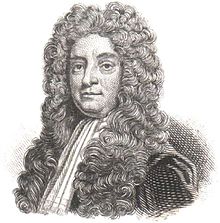Hans Sloane
Sir Hans Sloane, 1st Baronet (born April 16, 1660 in Killyleagh , † January 11, 1753 in Chelsea ) was an Irish scientist , medic and botanist . Its official botanical author abbreviation is " Sloane ". He was a passionate collector of antiques, paintings, curiosities and coins, among other things, these collections formed the starting point for the British Museum .
Life
At an early age he became interested in botany and natural history . After finishing school, he began studying medicine , chemistry and biology in London . He then traveled to France , where he continued his studies in Paris and Montpellier and received his doctorate in 1683. From 1687 he went on a long research trip to Jamaica .
Among his circle of friends were scientists such as Robert Boyle , Isaac Newton and Edmond Halley .
On January 21, 1685 Sloane was elected a member of the Royal Society and in 1727 appointed President, succeeding Isaac Newton. In 1699 he became a corresponding and in 1709 a foreign member ( associé étranger ) of the Académie royale des sciences . On April 3, 1716 he was given the hereditary title of baronet . In 1752 he was elected a foreign member of the Göttingen Academy of Sciences .
Hans Sloane was a passionate collector. In addition to his extensive herbarium , his collection includes insects , fossils , stones , coins , paintings and antiques from Egypt , Peru , North America and the Orient . This collection formed the basis of the British Museum in London . Sloane Square is also named after him . He bequeathed his book collection, including the original diaries of many contemporary buccaneers and privateers , to the Library of the British Museum , which today constitute the Sloane Collection of the British Library .
He married Elizabeth Langley-Rose, a wealthy widow who brought into the marriage several sugar cane plantations in Jamaica, where slaves were exploited. With her he had three daughters and a son, of whom only two daughters survived. For lack of male descendants, his baronet title expired on his death in 1753. Shortly before his death in 1753 he bequeathed many of his possessions and 71,000 of them made up a large part of the holdings of the British Museum.
criticism
Income from his wife's Jamaican sugar cane plantations contributed to Sloane's fortune. In the course of the Black Lives Matter movement, it was discussed that he had slaves work for him there, and his legacy was criticized. A bust of Sloane has since been exhibited by the British Museum only in the explanatory context of the British Empire .
Taxa named after Sloane
Carl von Linné named the genus Sloanea of the Elaeocarpaceae plant family in his honor . Pieter Cramer named the extinct Jamaican butterfly Urania sloanus after Sloane, Bloch and Schneider the viper fish Chauliodus sloani .
Fonts (selection)
- Catalogus plantarum quae in insula Jamaica… 1696.
- Voyage to the islands Madera, Barbadoes, Nieves, S. Christophers and Jamaica… 1707–1725.
- Pharmacopoeia [Pharmacopoea] Collegii regalis medicorum Londinensis . 4th edition, Knaplock, London 1721 (as editor; digitized edition )
literature
- Carl von Linné : Critica Botanica . Leiden 1737, p. 94.
- Entry to Sloane; Sir; Hans (1660 - 1753) in the Archives of the Royal Society , London
- Johann Gottlob Wilhelm Dunkel : Historically critical messages from deceased scholars and their writings . Cörnerische Buchhandlung, Köthen, 1757, Volume 3, p. 1041.
- James Delbourgo : Collecting the World: Hans Sloane and the Origins of the British Museum . Allen Lane, London 2017, ISBN 978-1-846-14657-2 .
Individual evidence
- ↑ Holger Krahnke: The members of the Academy of Sciences in Göttingen 1751-2001 (= Treatises of the Academy of Sciences in Göttingen, Philological-Historical Class. Volume 3, Vol. 246 = Treatises of the Academy of Sciences in Göttingen, Mathematical-Physical Class. Episode 3, vol. 50). Vandenhoeck & Ruprecht, Göttingen 2001, ISBN 3-525-82516-1 , p. 227.
- ^ A b British Museum removes bust of slave-owning founder Sir Hans Sloane ( en ) August 25, 2020.
Web links
- Author entry and list of the described plant names for Hans Sloane at the IPNI
- Correspondence between Hans Sloane and Carl von Linné
- About Hans Sloane, Natural History Museum, London
| personal data | |
|---|---|
| SURNAME | Sloane, Hans |
| ALTERNATIVE NAMES | Sloane, Sir Hans, 1st Baronet |
| BRIEF DESCRIPTION | English scientist, doctor and botanist |
| DATE OF BIRTH | April 16, 1660 |
| PLACE OF BIRTH | Killyleagh |
| DATE OF DEATH | January 11, 1753 |
| Place of death | Chelsea |
